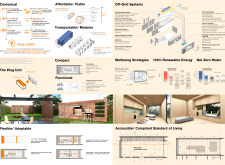5 key facts about this project
This design represents a synthesis of elegance and functionality; it is both visually appealing and purpose-driven. By prioritizing user experience and environmental stewardship, the project encourages occupants to engage with their surroundings. The architectural narrative unfolds through various spaces that cater to diverse activities, ensuring that each area is designed with specific functions in mind. The layout promotes accessibility and fluid movement, seamlessly guiding users from one space to another. This thoughtful circulation pattern is integral to the overall experience of the architecture, enhancing the usability of the design.
Key components of the project include an open-plan layout that encourages flexibility and adaptability, allowing for a range of activities to unfold. The incorporation of large windows serves as a significant design feature, maximizing natural light and enabling a visual connection to the external landscape. This design approach not only enhances the indoor environment but also cultivates a sense of well-being among users by blurring the boundaries between indoors and outdoors.
Materiality plays a crucial role in conveying the project's ethos. A selection of materials has been carefully chosen for their aesthetic qualities and performance characteristics. Sustainable materials such as reclaimed wood, locally sourced stone, and eco-friendly finishes highlight the commitment to environmental responsibility while providing warmth and texture to the spaces. The use of these materials not only elevates the design but also contributes to a sense of authenticity that resonates throughout the project.
Furthermore, the project exemplifies innovative design strategies, including passive heating and cooling systems, which minimize energy consumption. By incorporating elements such as green roofs or walls, the architecture actively contributes to biodiversity and enhances the ecological footprint of the site. This integration of sustainability principles within the design framework demonstrates an understanding of the broader implications of architecture in contemporary society.
The unique design approaches are evident in the way the project engages with its context. By embracing the site’s topography and existing vegetation, the architecture does not merely occupy space; it becomes part of the larger ecosystem. This contextual sensitivity encourages long-term sustainability and resilience, providing users with a dynamic space that evolves with its environment.
Overall, this architectural project is a testament to the thoughtful amalgamation of form and function, material choice, and environmental awareness. It serves not only as a structure but as a platform for interaction, community engagement, and experiential learning. The design stands out for its nuanced approach to contemporary architectural challenges, offering a solution that is accessible, responsible, and adaptable.
For those interested in delving deeper into the intricacies of this project, the architectural plans, architectural sections, and architectural designs provide vital insights that reflect the extensive thought and research invested in its realization. Exploring these elements can enhance the understanding of the architectural ideas that underpin this compelling design.























